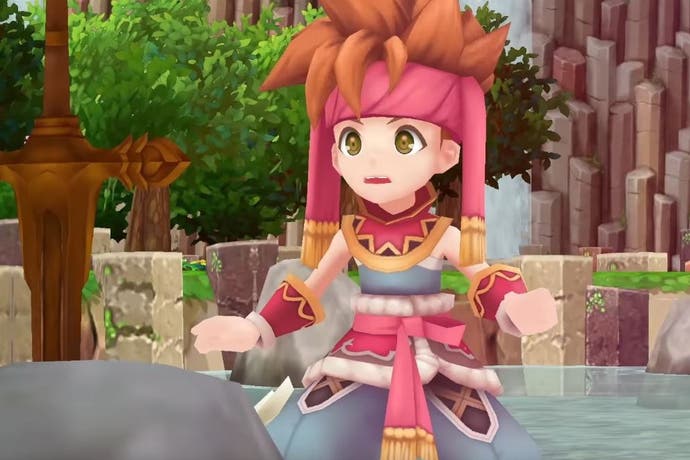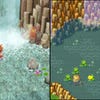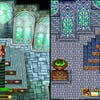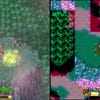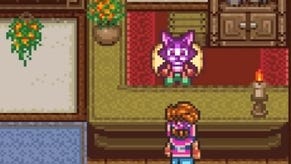Secret of Mana's 3D remake is good fun - but won't impress retro purists
PC, PS4, Pro and Vita versions tested.
A genuine Super NES classic, Secret of Mana holds a special place in the hearts of those that played it back in the day. Its blend of role-playing action, gorgeous visual design and evocative music remains a treat even today. The series has persisted across multiple generations since, but the original is still best. Or is it? Last week, Square-Enix released a 3D remake for PS4, PS4 Pro, PC and even PS Vita - and we've played them all.
But what makes this game special? Secret of Mana holds up today and was considered good enough to make the top 21 line-up for SNES mini, and this is perhaps surprising bearing in mind its troubled development. Originally designed for the Super NES's CD-ROM attachment, a collaboration with Sony, the game was originally lined up as a launch title for the Super Disc format - a vast adventure that would take full advantage of the extra disc space rather than simply slapping a few Redbook audio tracks on the disc like many other titles. When the CD project was killed off, Square management pushed the team to complete the game on cartridge instead. The team was forced to cut content and dialogue, reducing the game to the form we know today but despite obvious shortcomings resulting from this process, the game still went on to become a classic.
The action driven combat stands out as its most unique feature - up to three players can join-in for cooperative action, quite unlike anything else on the system at the time. While exploring the world in search of the eight Mana temples, players are treated to remarkable 16-bit pixel art. Beyond the expressive characters, beautiful rivers ripple through the numerous valleys, animated grass tiles blow gently in the wind and colour math is used to create some great effects.
The music, composed by Hiroki Kikuta, is perhaps one of the most impressive aspects of the game. In crafting the musical score, Kikuta created his own bank of samples lending the game an audio signature quite unlike any other. In the end, Secret of Mana was a great game but it's clear that its difficult development cycle resulted in some rough edges. Besides the missing content it often felt a little buggy. AI characters could easily become stuck on scenery, the sprite work when climbing stairs feels choppy, there's tons of slowdown and the camera system can be cumbersome. This explains why a full-on remake of the game has always held some appeal. This new iteration of the game attempts to recreate the original experience using relatively simplistic 3D graphics - something that has caused quite some commotion amongst fans.
It's true that the new 3D lacks the personality of the original pixel art but it's not particularly bad either. In many ways, it resembles a mid-generation PlayStation 2 title or perhaps one of the Mega Man remakes on PSP. It's a step down stylistically, but it still looks reasonably nice in motion. It is certainly evident early on that this project was likely produced on a relatively low-budget. Textures are used in many scenes to give the illusion of depth - walls which should exhibit lots of detail rely almost exclusively on flat textures, while the art itself is often very low-resolution. The overall level of detail feels quite ancient by today's standards. The colour choices also leave a lot to be desired with garish hues that fail to capture the aesthetic of the 16-bit version.
Another change made to this remake are the dialogue sequences. On Super NES, this is handled like any RPG of its day with text boxes. It's a mystery how this might have played out on the original Super Disc project but in the final game, it's just text. However, the remake introduces simplistic cutscenes complete with voice acting in either Japanese or English. The character models aren't half bad but the animation itself is displayed at 30 frames per second while the backgrounds continue to update at 60, leading to a strange mis-match.
There are also a lot of extra loading screens in the remake, complete with a rather boring font choice. For example, on Super NES, an early cave dungeon scrolls smoothly between different rooms and areas, but in the remake, most of these doors and tunnels are replaced with loading screens. The animation work also leaves a lot to be desired. Attack animations feel stiff compared to the rather unique stylings of the original game. That said, at least the developers have seen fit to sort out animation when climbing stairs - an aspect of the Super NES original that always looked ropey.
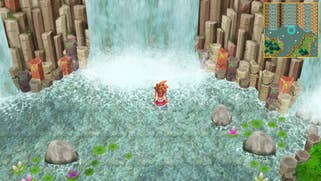


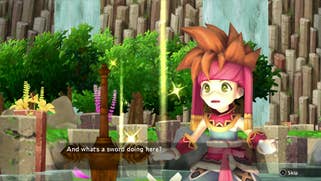
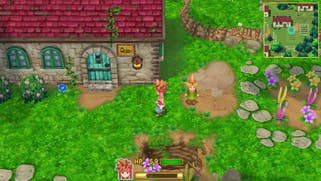
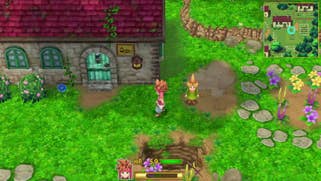
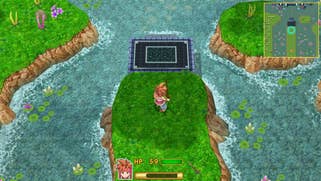
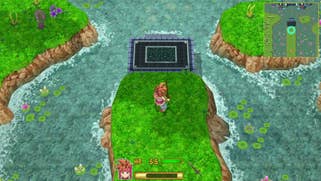
Overall then, despite some missteps, this remake has a mildly appealing aesthetic in a lo-fi 3D sort of way. We prefer the original, but this isn't half bad. There's also excellent image quality too. PlayStation 4 targets and achieves a locked 60 frames per second at 1080p resolution, which rises to full, native 4K on PS4 Pro. Both are backed by excellent anti-aliasing. It's a very simplistic game, no doubt, but at least it's extremely clean and crisp.
Secret of Mana is also remarkable in that it features a full PlayStation Vita port - which is both a good and a bad thing. Let's start with the good. Visually, the Vita version is comparable to PS4. It runs at the Vita's native resolution and features detail on par with its bigger brother. Texture quality is pared back a touch and the water surface shader has been modified but overall, it's nearly a match. It's so close that it feels as if the game was limited in terms of visual quality to work within the confines of Vita.
Unfortunately, even if that were true, there's a real problem here - performance. While the PS4 and Pro versions lock to 60fps, the Vita really struggles. This is an action RPG and demands reasonably responsive controls and smooth performance to play at its best and the Vita simply can't deliver this. Instead, it operates with a fully unlocked frame-rate that often hangs just above 30fps but equally as often, it drops below. Running around the world feels remarkably choppy because of this issue. Also annoying is the bizarre lack of PlayStation TV support. There is literally no reason why this should not be included - we ran the game perfectly with full functionality on a hacked unit.
Of course, certain smaller rooms actually do manage to almost hit 60fps but this is extremely uncommon. That's really the main problem here - the Vita port looks nice enough but playing a 16-bit style action RPG at such an abysmal frame-rate really isn't appealing at all and makes for an experience much worse than PS4. It was never completely fluid on the Super NES but the Vita experience is much worse than the original.
The PC version is a little more interesting, even if there is an almost complete lack of visual settings to tweak. Full-screen mode isn't even exclusive full-screen, which also sets off alarm bells. However, the port is a little better than you might first believe. Aside from having low requirements and running smoothly on lower-end hardware, it also supports both higher frame-rates, enabling smooth scrolling above 60fps if you have a capable display, and there's full support for ultra-wide monitors. An overhead game such as this greatly benefits from ultra-wide support and it looks great. We played the game at 3840x1600, locked to the display's 75Hz refresh and it was an excellent experience. Beyond that, it's identical to the PS4 version.
Overall then, this remake of Secret of Mana is an interesting product. It feels like a budget game in many ways and lacks the charm provided by the original 2D art, but there's still something about it that works. At its heart, it's a good game even with its controversial 3D art and the more responsive performance helps make for a very playable game. It's a tough sell, however, as we suspect users that have never played the original release may get more out of it than those that have - it's always difficult to assess a remake like this when nostalgia is so strong. We don't believe that Square-Enix has been fully successful here, but we're still glad that this remake exists. If anything, it's a chance to see the world of Mana through a new filter.
